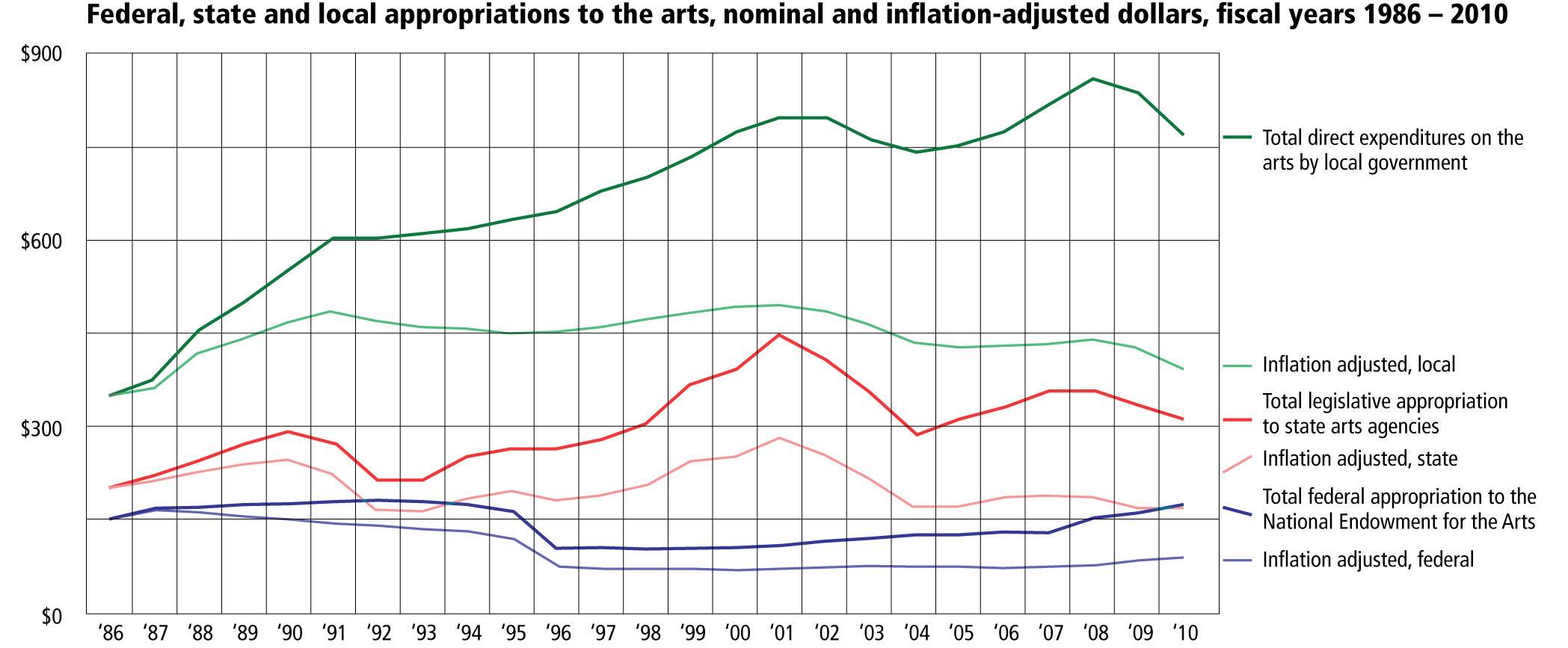Public Funding for the Arts: 2010 Update
Current Funding
The three primary sources of government support for the arts in the United States are federal appropriations to the National Endowment for the Arts (NEA), legislative appropriations to the nation’s state arts agencies, and direct expenditures on the arts through county and municipal governments. In 2010 the NEA received $167.5 million, state arts agencies received $307.1 million, and local expenditures were $765.0 million. Compared to the prior year, state appropriations and local expenditures experienced declines (6.9 percent and 8.1 percent, respectively), while appropriations to the National Endowment for the Arts grew by 8.1 percent. Combined, these three public funding streams account for $1.2 billion in arts support, or about $3.98 per capita. Public sector grantmakers use these funds to support a wide array of arts activities, artistic disciplines, public participation initiatives, and institutional grants to encourage community creativity and make the arts highly accessible to the public.
Dollars mentioned here and in the accompanying graph do not include $50 million in special, nonrecurring funds appropriated to the NEA as a part of the American Recovery and Reinvestment Act (ARRA), commonly referred to as stimulus funds. These funds were awarded in 2009 by the NEA, states, and some localities for the purposes of short-term job preservation in nonprofit arts organizations.
Trends Over Time
State funding is historically a more volatile part of the government arts funding mix, contracting sharply during recessions and growing relatively quickly in times of economic expansion. However, state arts funding did not fully recover from cuts received in the early 2000s. This made the declines of the past three years especially challenging for state arts agencies and their grantees. Local government arts spending is similarly affected by the economy. While increases and decreases have historically been less acute than those seen in state funding, in 2010 local spending experienced a decline sharper than state funding. In fact, it was the steepest decline in twenty-five years.
While most state and local governments are required to maintain balanced budgets each year, the federal government is not. In the past, political influence has been a relatively more powerful driver than economics in shaping federal funding for the arts. Appropriations have grown steadily over the past ten years and have remained relatively stable during the two most recent recessions. Current NEA funding, however, still falls short of its 1992 peak.
Although the long-term growth in total public funding is a notable achievement in a competitive fiscal environment, government arts funding at all three levels has been challenged to keep pace with the costs of living and doing business. When adjusted for inflation, funding has increased by 11.6 percent at the local level since 1986 and decreased by 19.8 percent at the state level. Federal funding is about half the appropriation amount from twenty-five years ago. In inflation-adjusted dollars per capita, funding from local, state, and federal sources has decreased by 31 percent since 1986.
Outlook
As the second major economic contraction in less than a decade, the current recession is causing significant distress in government budgets. Fiscal analysts also express long-term concerns about tax structures and the inexorable escalation of health care, retirement, and education costs. State arts agencies are expecting further funding cuts in this current environment, estimating a 12.9 percent decline in appropriations for 2011. In light of these reduced budgets, agencies have focused programs on sustaining arts organizations and artists, increased partnerships and services, and further reduced internal costs.
Congress continues to favor modest growth for the National Endowment for the Arts. As appropriations develop for the 2011 fiscal year, the House of Representatives recommends an increase of $3 million, while President Obama proposes a cutback to $161 million as part of an overall strategy to reduce the size of the federal deficit.
In this environment, public sector grantmakers and cultural advocates are emphasizing how the arts contribute to economic and community resiliency and add value to other economic recovery policy strategies. Public arts leaders are also promoting the economic, educational, and civic return on the investment of taxpayers’ dollars, emphasizing how public funding, earned income, and philanthropic support all are required to sustain vibrant and prosperous communities.

